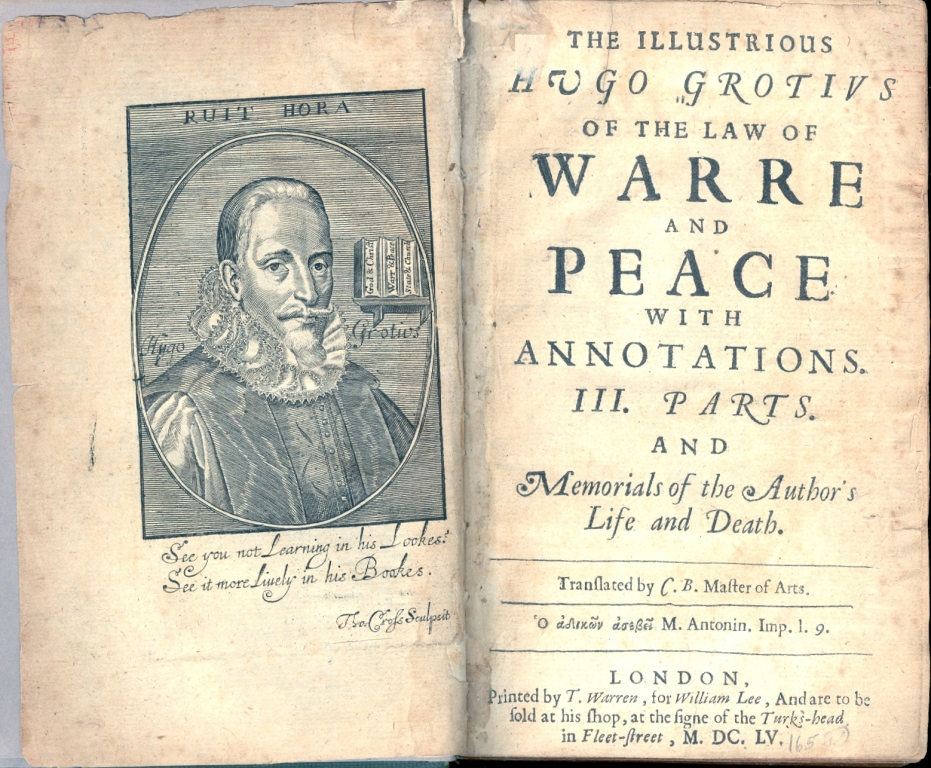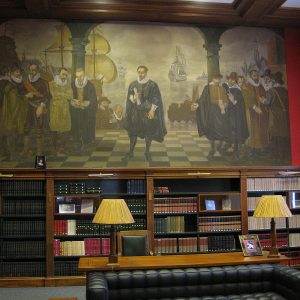JEROEN VERVLIET
This VN Forum special is all about ’100 years of The Hague Peace Palace’. This article tells more about the ideas behind the Peace Palace.
Andrew Carnegie
It all began with the Scottish-American nineteenth-century industrialist, multi-millionaire and benefactor, Andrew Carnegie (1835-1919). He was persuaded by the Russian diplomat F.F. de Martens, the grand architect of the idea of ‘peace through justice’, fulfilled by the establishment of the Permanent Court of Arbitration at the First Hague Peace Conference of 1899, and convinced by Bertha van Suttner, the pacifist author of ‘Die Waffen nieder’ (Lay Down Your Arms), to support financially the construction of the Temple of Peace for the aforementioned Permanent Court of Arbitration.
A ‘Standard Library of International Law’, for the Court itself and equally for the whole world, had to come into existence simultaneously. However, the scale and scope of this Library of International Law and Diplomacy overtook the original suggestion of Andrew Carnegie, for it became too large and too dominant. Still, in the end, Carnegie, founder of thousands of public libraries worldwide, who had been illiterate in his youth and for whom the word and the book contained magical powers, yielded and approved.
Mission
Access to information as an element of freedom of information and freedom of expression is nowadays considered a fundamental human right. The internet age is the era of democratic sharing of knowledge. During the early years of the Peace Palace, documentation was not necessarily available to everyone, neither to parties in an international dispute nor to an ordinary legal scholar. A principal – almost philosophical or ideological – objective of the Peace Palace Library has been the open access to books, journals, documentation, government publications, case law series, etc., in order to enable all countries and persons interested to become knowledgeable and especially about the position of the opposite side in a pending conflict, since appropriate knowledge on the views and position of the counterpart is the most uncomplicated bridge to reach an understanding for the solution of a controversy.
In that sense libraries in general and the Peace Palace Library in particular can develop into tools for peace education, paving the way to a global nuclear and conventional disarmament, to awareness of the harmful international effects of environmental pollution, to multicultural tolerance and apprehension of the expanding world.

Hugo Grotius’ War and Peace
Special Collection 1: Hugo Grotius
Soon after the formal opening, in 1914, Wouter Nijhoff, director of Martinus Nijhoff-Booksellers & Publishers in The Hague, and renowned bibliographer and humanities scholar, donated his personal collection of copies of Hugo Grotius’ ‘De Iure Belli ac Pacis’ (On the Law of War and Peace), in various languages, to the Peace Palace Library. The Nijhoff-assortment comprised 55 editions, of course in Latin, the original language of the publication, but also in French, English, German and Dutch. A 1625 first edition of ‘De Iure Belli ac Pacis’ was as well included in the bundle of donated books.
Dr. Jacob ter Meulen (1884-1962), Peace Palace Library Director from 1924 until 1952, a legal history scholar, a Hugo Grotius specialist and pacifist, relentlessly worked on the expansion of the Hugo Grotius book collection in particular, and by doing so he built upon the first bricks laid by his predecessor Dr. P.C. Molhuysen. As if it were an obligation emanating from the initial gift by Nijhoff, Ter Meulen gave birth to the largest Hugo Grotius collection in the world, by broadening the ‘On the Law of War and Peace’ book collection and by extending to other fields of Hugo Grotius’ scientific work.
The Peace Palace Library currently holds approximately +/- 200 ‘De Iure Belli ac Pacis’ editions (in all languages imaginable), 100 other international law titles by Grotius, e.g. ‘Mare Liberum’ (The Free Sea), other law titles (On Jurisprudence), history, theology, philology and poetry, now all in all 1,200 volumes, 50 meter shelf-length.
Special Collection 2: Peace Movement, Images and Posters and League of Nations philately

Peace Palace Library, wall painting with Hugo de Groot (Hugo Grotius) in old catalog room, 2014
Dr. Jacob ter Meulen, a mennonite and pacifist, was strongly connected to the International Peace Movement during the Interbellum. This involvement has resulted in the composition of a unique collection documenting the internationalist and pacifist activities, often of an informal publicizing character. It consists of leaflets, pamphlets, letters, postcards, songs and newspaper clippings.
A special part of this Special Collection contains all kinds of images and poster, representing peace or anti-war sentiments (also on the post-World War II epoch). The Peace Palace Library has started to upload this special collection to the library website. Half a decade ago the Peace Palace Library has succeeded to acquire a truly extraordinary philately collection, not so much on peace alone, but merely mirroring the League of Nations years. It concerns a worldwide appraised and awarded philately collection, safely stored in vaults outside the Peace Palace, composed by the Dutch philatelist Anton van Deutekom
The Library, Its Scope and Scale 1913 – 2013, and Beyond
The Peace Palace Library has three main target groups: 1] international courts; 2] The Hague Academy of International Law; and 3] the world at large. In the first category of target groups, the most important amongst the international courts to be served is the International Court of Justice (ICJ), one of the six Principal Organs of the United Nations. The second court is the Permanent Court of Arbitration (PCA). Thirdly it is the group of general courts and international criminal courts, e.g. the International Criminal Court (ICC, established with the 1998 Rome Statute), Dutch District Courts (International Criminal Law in Domestic Courts-Chamber in The Hague), and interestingly, the Dutch Supreme Court (in particular for comparative legal research). The Hague Conference on Private International Law is also to be counted amidst the principal institutional end users.
The second visible and tangible target group consists of the Hague Academy of International Law, a well-established summer school existing since 1923, for which the Peace Palace Library, as a sister organization, deploys general activities, and special ones, e.g. a dedicated digital library, an e-learning facility.
The third category is to be characterized as undefined end users: professors, scholars and students. This group, real and virtual, is geographically distributed worldwide, but of increasing interest, due to globalization and to The Hague as Legal Capital of the World.
For rendering services to all these categories the Peace Palace Library has been building a collection on International Law, Comparative Law, and the international and diplomatic history of conflict areas for the sketch of the context in which controversies occur since 1913, and by doing so the Peace Palace Library has always strived to anticipate any future issue that may arise.
The so-called Printed Catalogue of the Peace Palace Library acted as the cornerstone for International Law documentation and activities worldwide, up to the Second World War. Thereafter the Peace Palace Library went through a recession, a depression and a downswing for several decades. Unmistakably this development parallels the lesser importance of, or belief in, or compliance with International Law in the era of the East-West polarity of the Soviet-USA Cold War.
After the doldrums in which the Peace Palace Library still had its obligation to maintain, continue and follow a ‘just-in-case’ collection policy, the United Nations’ Decade of International Law and The Hague becoming the Legal Capital of the World resulted in a renewed and even growing importance of the Peace Palace Library. Library automation, the digital library and the modern website have led to a reconstitution of the Peace Palace Library, culminating in an international recognition of its role and value. Through topical research guides, prioritizing the content of the library and its intellectual power, the Peace Palace Library reaches out to the world. The library dispatches alerts to its users, containing the new acquisitions. It distributes a monthly newsletter, weekly blogs appear on the website that relate in a library sense to hot issues in international law or contemporary politics, as do the Peace Palace Library lectures that are being held every three months. Last but not least, the Peace Palace Library tries to optimize social media – even a virtual tour is on its website – for its name and fame as international anchorage.
Birthday Present
At the 2013 Spring auction of ‘The Romantic Agony’ in Brussels the Peace Palace Library succeeded to purchase a 1499 edition of the ‘Institutes’ of Gaius, a law student handbook containing an exposition of the elements of Roman law, dating back as far as the second century, becoming part of the ‘Corpus Juris Civilis’ in the sixth century. Hugo Grotius refers to Gaius and herein lies a good argumentation for acquiring this late fifteenth century edition, printed by Baptista de Tortis in Venice.
Natural law did still play a vital role in Grotius’ legal reasoning (cf. ‘De Jure Belli ac Pacis’, Book I, chap. I, pars x, 1); the ‘recta ratio’ or natural reason, dictating natural law, was part of ‘Jus Gentium’, the law of nations or the common law of mankind. Gaius equals natural reason and therefore ‘Jus Naturale’ with the law of nations or ‘Jus Gentium’, common to all men, contrary to Civil Law or Roman state law (Book I, chap. I, § I).
The initial donation of 1913 to the Peace Palace Library by Nijhoff, bookseller in The Hague, containing various precious editions of ‘De Jure belli ac Pacis’, received its intellectual follow-up with the purchase by the Peace Palace Library of the ‘Institutes’ of Gaius, because of the centenary of the Peace Palace in 2013, thus contributing to the aggrandizement of its own ‘History of International Law-collection’.
Website: http://www.peacepalacelibrary.nl/
